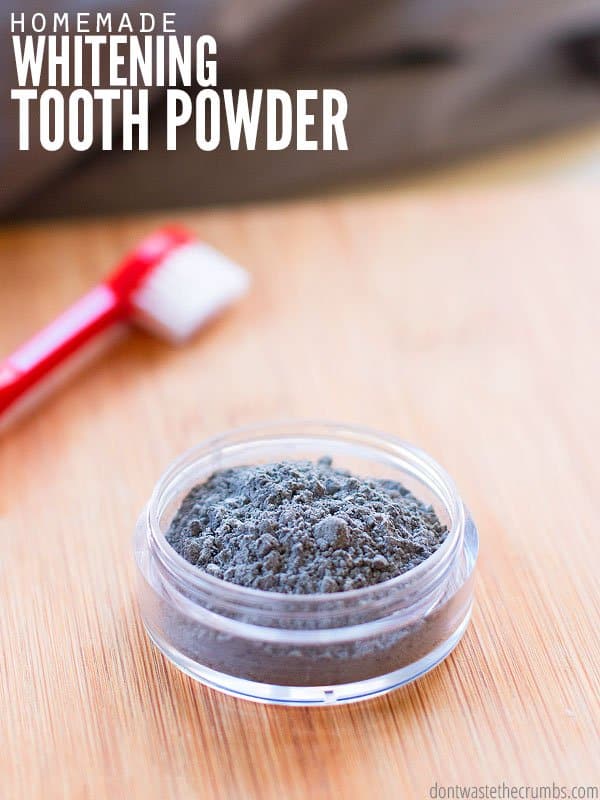
Dabbling in DIY’s is my favorite pastime as an inexpensive way to improve my health, or quality of life… in one way or another.
For example – my husband once healed a spider bite with a potato and he also removed a mole with apple cider vinegar. When there wasn’t ANY funds left in the budget for make-up and I still wanted to feel pretty, I learned how to make my own powdered foundation.
I once made my own homemade toothpaste (that tastes just like Earthpaste!) just to see if I could. It turned out so well, I’ve been making it ever since!
My most recent endeavor? Activated charcoal teeth whitening powder.
If you’re new to this blog, you’re probably wondering what activated charcoal is, or what tooth powder is. Let’s cover the basics.
What is Activated Charcoal?
First, activated charcoal is NOT the ashes leftover from the grill. Please don’t eat those, or you will get sick.
Activated charcoal is actually a natural substance made from bamboo, wood, or coconut shells that are burned without oxygen to create char. Char goes through a multi-step process to make it very, very porous. At this point, it’s considered “activated.”
Activated charcoal works through adsorption, meaning it pulls toxins into itself. It’s then flushed through the body as waste since the body cannot absorb activated charcoal.
Second, it’s worthy to note, that activated charcoal is so effective at removing toxins, that many hospitals use it for overdose and poisoning!
Finally, while activated charcoal removes toxins, it also removes good stuff too… like probiotics and medicine. This is probably more important if you’re eating activated charcoal gummies for the stomach flu, rather than just brushing your teeth with it (as in the activated charcoal teeth whitening powder recipe below) or even making a simple detox face mask, but still. Now you know!
What is Tooth Powder?
That’s easy – it’s just like toothpaste, except it’s a powder! You get all the benefits of all natural toothpaste (including re-mineralization!), without the fuss and mess of making a paste.
Can you make toothpaste out of tooth powder?
Sure! Just add enough distilled water (1-2 tablespoons at a time) to achieve the texture you want. Be sure to stir REALLY well with each addition of water.
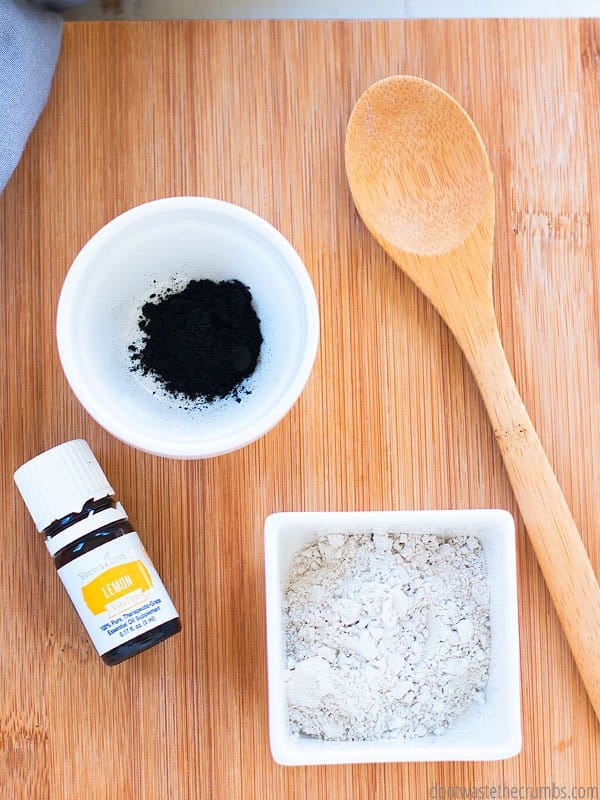
What is Bentonite Clay?
The second main ingredient of activated charcoal teeth whitening powder is bentonite clay. This is what I used in my original homemade toothpaste recipe, and it’s what we attribute to my husband being able to heal his gum disease too.
I’ve written about the health benefits of bentonite clay and the different ways to use it, but suffice to say that it’s also very powerful at removing toxins AND helps to keep the teeth healthy.
Like activated charcoal, it removes toxins via adsorption (i.e. pulling toxins in towards itself like a magnet). However, bentonite clay also removes toxins via absorption, drawing them in like a sponge.
The fact that bentonite clay contains 60 trace minerals that the body needs means you’re giving your mouth a boost of nutrition it needs for healthy teeth, on top of getting them sparkly clean!
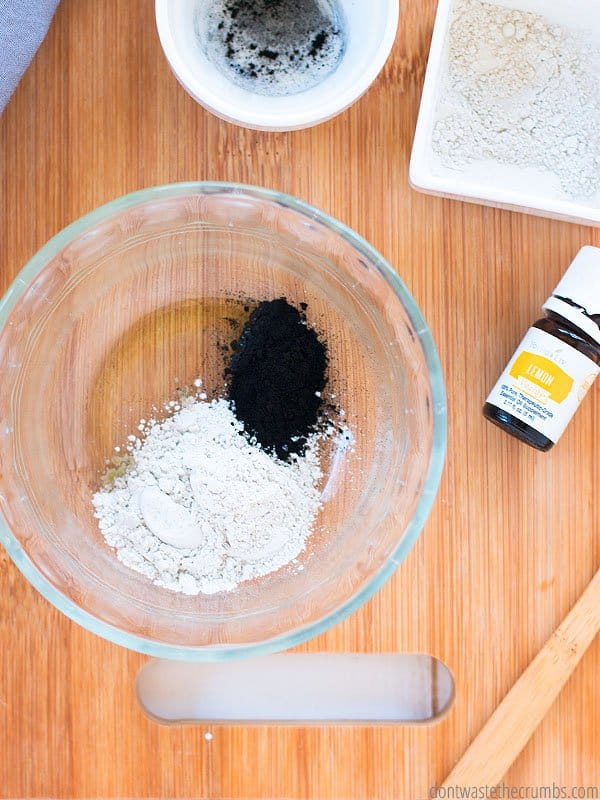
Caution & Recommendations When Using Activated Charcoal Teeth Whitening Powder
While this whitening tooth powder is very effective, it isn’t meant to be used on a daily basis.
I am not a doctor, but I recommend using it every other night for about a week or until you see improvement with the color of your teeth. Then brush roughly twice a week to maintain your bright smile.
As always, stop using immediately if your teeth or gums become sensitive. (Mine were sensitive the second time I brushed, but it went away after the third time.)
I don’t recommend activated charcoal teeth whitening powder for children, for two main reasons.
- It stains.
- Children aren’t always the best at NOT swallowing.
While digesting activated charcoal is a “bad” or “harmful” thing, it does take the good stuff from your gut with the bad… and since the good bacteria in our belly is what keeps us healthy, we should avoid digesting activated charcoal unless it’s absolutely necessary (like when the whole house has the stomach flu.)
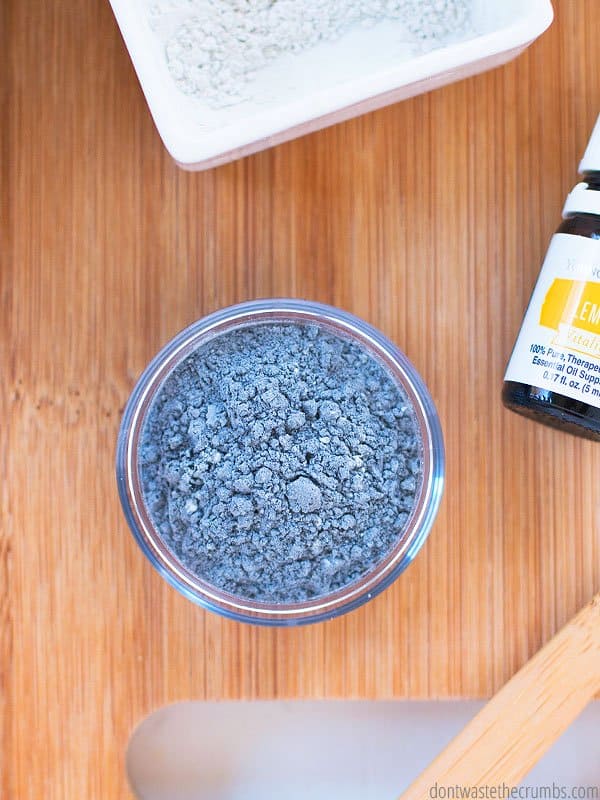
Why Make Activated Charcoal Teeth Whitening Powder?
Honestly? Because I’d like my teeth to be a little whiter.
I don’t want the to glow in the dark or anything, but I wouldn’t be opposed to a few dashes brighter… know what I mean?
It’s the season for pictures and get-togethers and whatnot, so why not do what I can to have a more confident smile?
How to Make Activated Charcoal Teeth Whitening Powder

Activated Charcoal Teeth Whitening Powder Supplies
- 1 Tbsp bentonite clay (I started with this small tub at first, but now buy bentonite clay in bulk since I use it for SO many different natural remedies at home, and it’s cheaper!)
- ½ tsp activated charcoal (this is the kind I have)
- About 5 drops Lemon Vitality essential oil** (optional, for flavor)
- Plastic or glass jar for storage (I used these small 5 gram pots, leftover from making my own lip balm. Use whatever you have, as long as it’s not metal. See notes below.)
Note: I really like Plant Therapy essential oils. You can find their shop here.
Activated Charcoal Teeth Whitening Powder Method
In a small glass jar, measure bentonite clay. Add activated charcoal and Lemon Vitality essential oil (if using) and mix well using a plastic spoon. Store in a plastic or glass jar.
To use, wet your toothbrush and dip it in the powder. Brush as normal, taking care to spit directly into the drain while the water is running to prevent the charcoal from staining.
Note: If sharing the pot of tooth powder with your spouse gives you the heeby jeebies, divide the powder between two so you each have your own!
Tutorial Notes:
- Bentonite clay pulls the toxins from metal, which is why we’re using a glass jar and plastic spoon.
- We’re also using a plastic spoon because activated charcoal stains, and I wouldn’t want you to have white teeth at the expense of ruining a good spoon.



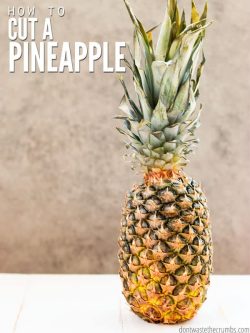


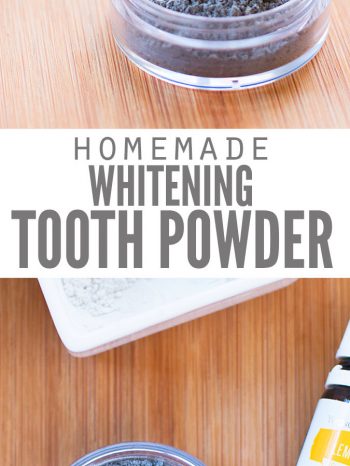
I’m so excited to try this recipe and even more excited to have found this brilliant website!
My question is, what is wrong with using the activated charcoal toothpaste on a daily basis? ( Since you are not swallowing the charcoal what could be the downside? It’s not abrasive to the teeth like baking soda, so I just don’t see the potential source of the problem..)
A cautionary note about using plastic containers and spoons with any brand of lemon EO or other EO’s like thyme, etc.
Lemon oil is a great petrochemical detoxifier BUT I’ve seen it start to dissolve a plastic spoon fairly quickly (Y.L. brand) any high quality lemon oil acts the same.
My personal experience comes from using EO. in making bee feeding syrup using a very small amt. to be diluted into the syrup. I had to throw out the batch as i saw it had started to dissolve the plastic spoon it was sitting in.
Of course no one is going to use full strength lemon EO in their mouth! But even storing a toothpowder mix containing it in plastic may give it time to start extracting petrochemicals from the container.
I only use glass containers and personally use a silver spoon or wooden when needed to mix with.
Thanks for the reminder Yvonne!!
I’m going to make this toothpaste. Just curious if you were to use the orange peel and peppermint extract powders how much would you use. Trying to determine how much of each ingredient I need.
I’m really not sure Christy – I always add flavors to taste!
Activated charcoal can also absorb tannins or the molecules in foods and drinks that can cause staining. It can be included as an ingredient in toothpaste, or its powdered form can be mixed with water and then scrubbed onto the teeth. However, before your start using activated charcoal to get whiter teeth, it is important that you know exactly what to expect when you use it and why it may not be the best choice for your oral health routine.
>Bentonite clay pulls the toxins from metal, which is why we’re using a glass jar and plastic spoon.
Yikes! Glad you mentioned this. I had a little tin in mind that thought would be perfect for storing this in, but I guess not! I’ll have to scrounge up some plastic something or other.
I have a few old “metal” fillings and had read somewhere about bentonite clay drawing out the mercury. Do you know anything about that? I’d love to try this but am wary for that reason.
Hi Dana! Bentonite clay can absorb and bind toxins to metal, and I’ve read that for most people, fillings are not an issue because of the short contact with the toothpaste. If anything, it will draw out toxins and you’ll spit them out!
Okay! Thanks for the quick reply.
I didn’t see where you talked about why not to store it in a metal container.
Bentonite clay absorbs toxins, and most metals contains toxins of some sort. Over time, this could contaminate your tooth powder.
Do you brush with toothpaste after using the teeth whitening?
No, I use the teeth whitening powder AS toothpaste, since bentonite clay has cleaning properties.
Hi – this is the only blog I’ve been able to come across that uses both bentonite clay and activated charcoal for the teeth. I made a homemade toothpaste that included these two ingredients as well as coconut oil and baking soda. It’s been about 3 weeks and my teeth are now starting to stain. Do you happen to know the reason why? And is there a way to reverse this?
Thanks,
Leslie
I don’t know Leslie – I’ve never heard of teeth staining with either of these ingredients. My best guess would be to make sure you’re thoroughly brushing the powder off, and consider what else you’re eating. Foods likes berries and wine can stain your teeth!
Wondering if you’ve checked in with a dentist on whether it could wear away at tooth enamel? My sister is a dental assistant and she said to never use baking powder on teeth as it wears away people’s enamel. I’m wondering if that could be try of the charcoal as well?
We haven’t had a dentist appointment since using this yet Stephanie, but I’ve talked with several natural-minded friends and no one has mentioned abrasiveness of charcoal. However, the abrasiveness of baking soda is very common. I’ll update if our dentist says anything!
Why capsules instead of more of a bulk buy? Having to break capsules seems tedious. But I also do not know what to look for in quality either
I chose capsules because when I first bought activated charcoal, I wasn’t sure how much was appropriate. A little bit goes a long way, and I’m still on my original bottle. 🙂
what is the difference, or is there a difference between bentonite clay and CALCIUM
bentonite clay? thanks
Calcium bentonite clay is a gentler clay.
I make tooth powder with bentonite clay, French green clay, and baking soda. My dentist has never seen my teeth and gums since I started! I was told to keep using my homemade mix and get rid of toothpaste!
I love your dentist’s advice!!
hai Stephanie, do you use this mixture everyday?
Wondering if it will stain capped teeth?
I’m not sure Arleen. It stains porous surfaces, like grout or formica countertops. It doesn’t stain anything that’s sealed… or at least, it hasn’t for me so far. I just cleaned my counter and found some I missed the last time I cleaned – gone without issue!